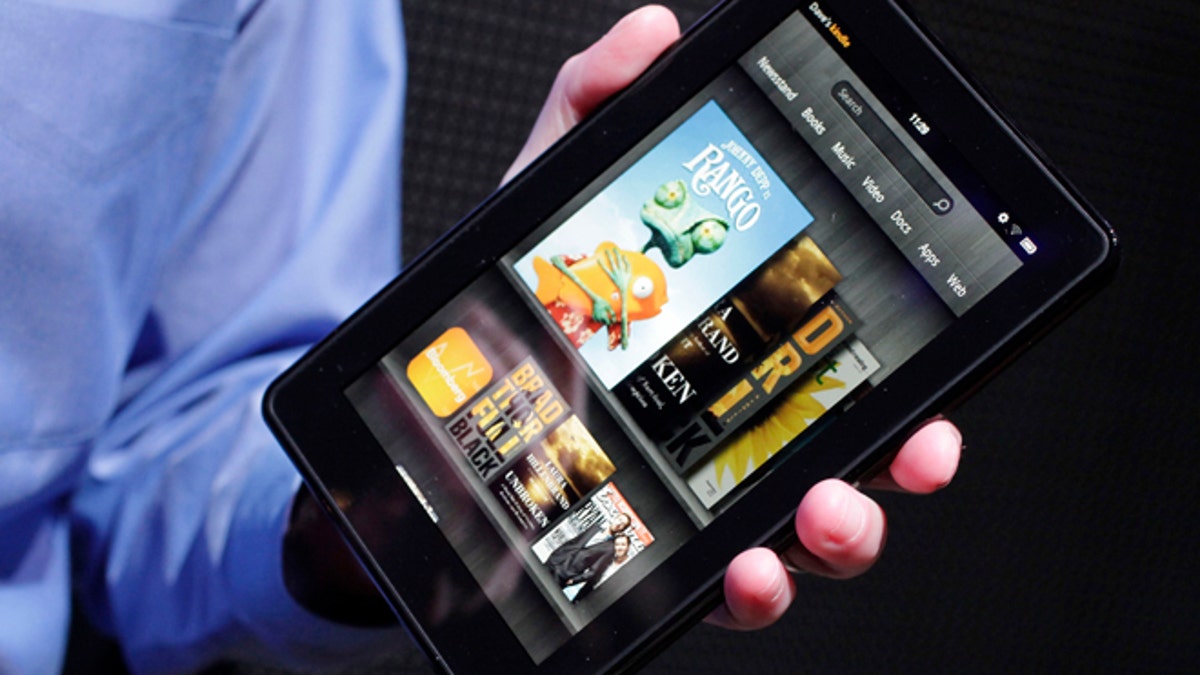
Apple has successfully fended off competitors who have tried to sell tablets in iPad's size range. But last year, Amazon.com figured out how to crack Apple's stranglehold on tablets by making a half-size, no-frills tablet. The result was the Kindle Fire, which sells for $199 -- basically, the cost of production. Amazon has sold millions of them. (P Photo/Mark Lennihan)
NEW YORK – Apple generates more gossip than the Kardashians.
There's a constantly spinning mill of rumors about Apple products, most of which turn out to be untrue. What's unusual this week is that talk has revived of a smaller iPad model, an idea company founder Steve Jobs derided publicly a year before he died.
Apple and its suppliers aren't commenting. Rumors of a smaller iPad, or "iPad mini" have percolated ever since the first iPad was launched two years ago. This time around, they're fed by media reports from South Korea, China and Taiwan, saying Apple has ordered Samsung screens that are 7.86 inches measured on the diagonal. That would make the screen about two-thirds the size of the current iPad, which has a diagonal measurement of 9.7 inches.
WHY IT'S A GOOD IDEA:
A smaller tablet would help Apple further its lead in the tablet market.
"From a competitive standpoint, we believe an iPad mini with a lower price point would be the competition's worst nightmare, says Shaw Wu, an analyst at Sterne Agee. "Most (competitors) already have a tough enough time competing against the iPad 2, as well as the new iPad."
Apple has successfully fended off competitors who have tried to sell tablets in iPad's size range. But last year, Amazon.com Inc. figured out how to crack Apple's stranglehold on tablets by making a half-size, no-frills tablet. The result was the Kindle Fire, which sells for $199 --basically, the cost of production. Amazon has sold millions of them.
Apple sells the iPod Touch for $199, but its screen is about a quarter of the size of the Kindle Fire -- a big disadvantage for people who want to enjoy books, movies and games. It also sells the older iPad model for $399. It has nothing in between.
Price isn't the only reason customers might prefer a smaller tablet. A 7-inch model would fit in many handbags, unlike the current iPad.
Wu says he's seen evidence of Apple experimenting with both smaller and larger tablet screens since 2009, and doesn't sense that the release of an iPad mini is "imminent."
WHAT IT MIGHT COST:
It could be hard for Apple to make money from an iPad-quality 7-inch tablet that sells for $299. Analysts at IHS iSuppli estimate that a smaller tablet would cost around $250 to produce, a figure that doesn't include development costs, packaging or patent royalties. That suggests Apple would price it at $329 or $349.
"The first thing you always have to keep in mind is: Apple is not going to sell an unprofitable product," says Rhoda Alexander at iSuppli.
WHY IT'S A BAD IDEA:
A smaller iPad would be a headache for software developers.
"Going to a different screen size ends up being a ton of work," says Nate Weiner, the creator of Pocket, an application that stores Web pages and other material for later reading.
"If you take, for an example, an interface built for the iPad and try to cram it into the Kindle Fire, it just doesn't fit," he says.
However, developers who have already adapted their programs to the Kindle Fire or other 7-inch tablets wouldn't face a big hurdle in adapting to a third Apple screen size, Weiner says.
WHAT JOBS THOUGHT:
Apple's late CEO made a rare appearance on an October 2010 earnings conference call to launch a tirade against the 7-inch tablet Samsung Electronics Inc. was set to launch as the first major challenger to the iPad.
"The reason we wouldn't make a 7-inch tablet isn't because we don't want to hit a price point, it's because we don't think you can make a great tablet with a 7-inch screen," Jobs said. "The 7-inch tablets are tweeners, too big to compete with a smartphone and too small to compete with an iPad."
He said the resolution of the display could be increased to make up for the smaller size, but that would be "meaningless, unless your tablet also includes sandpaper, so that the user can sand down their fingers to around one quarter of the present size."
"There are clear limits of how close you can physically place elements on a touch screen before users cannot reliably tap, flick or pinch them. This is one of the key reasons we think the 10-inch screen size is the minimum size required to create great tablet apps," he said.
Jobs failed to mention Apple's success developing apps that use taps, flicks and pinches on the iPhone, with its 3.5-inch screen.




















